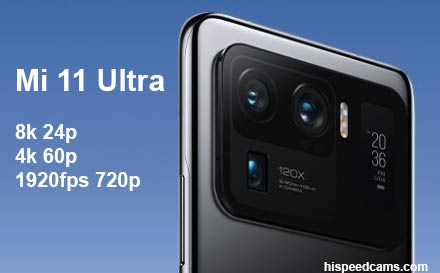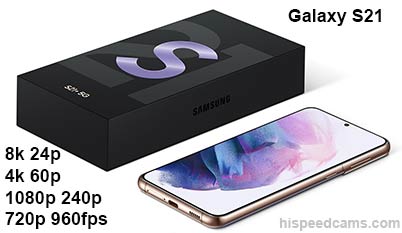Our of our readers Chinito Pinoy has shared a pretty remarkable video with us that we would like to share. It is upscaling of sub HD resolution high-speed video at 240p, 480p and 960p from the Sony RX10 IV at 480 and 960fps and the A7S Mark III at 240fps from Sub HD to 4k UHD.
Tag Archives: 960fps
BEST SLOW MOTION CAMERAS OF 2021!
We have passed another year in slow motion land and while camera releases were more plenty than expected considering the chip shortage and teh COVID disruption, it’s time to take a look back through the year’s camera releases, and see which delivered on the price/performance scale when it comes to slow motion frame rates. Phones are stagnationg while high end cameras are getting more frame rate options in higher resolution. Our Best Slow Motion Cameras Of 2021 have been selected and ordered by recommendation!
GoPro Hero 10 Leaks with 240fps in 2.7k!
It seems the leaks have come down heavily on the to be formally announced Hero 10 Black from GoPro. The latest by Winfuture.de & @rquandt. The most important part of the leak speaks about the use of the new GP2 chipset which is at least 2x faster than the already long in the tooth GP1 which was a great processing unit when released a few iterations back but now has a bit of catch up to do.
The leak also talks about new Hypersmooth 4.0 which seems to use also the oversampled sensor to deliver gimbal-like motion stabilization performance for the camera without the use of a physical stabilizing unit. We really like Hypersmooth 2 and 3 and if the GP2 is such a better processing core, it should in theory yield even better smoothness on most footage resolutions. Frame rates have also taken a big leap here, and we speculate on what it could mean for slow motion enthusiasts.
Xiaomi Mi 11 Ultra Slow Motion Mode 1920fps Fake?
Xiaomi has surprised this year with now the Mi 11 Ultra phone which is a big step up from the Mi 11 released earlier this year. The huge difference lies in the size of the sensor which is close to a 1″ camera sensor like those found on the Sony RX camera series for example. The phone has two 48MP sensors and a main 50MP sensor for the main camera with a highly protruding camera bump that really screams for a case to be able to balance well on a flat surface.
The slow motion modes on the phone are rumored to be the garden variety with 120fps/240fps 1080p, 60fps 4k, and also a selfie camera that does 720p 120fps which is becoming commonplace. What is really peaking our interest is the 1920fps slow motion mode that is touted by some reviews. It is unclear what the phone is capable time-wise as the specs are still not all there. The samples we have seen show detail loss and the clear signs of interpolation.
Galaxy S21 Slow Motion Feature is Retained!
This week we had the announcement by Samsung of the Galaxy S21 phone line which is the de-facto Android handset in most of the world. The Galaxy S21 Slow Motion has essentially the same feature set as the Galaxy S20 of 2020 when it comes to high-speed video. The Galaxy brand went serious with Slow Motion since the Galaxy S9 with the 960fps mode at 720p which we can still see here with somewhat improved resolution and recording time.
The S21 line is by almost any standard a refinement of the line with very subtle but important updates on the previous S20 phones. We get the Snapdragon 888 which is the brightest and fastest SoC in non-Apple land. We get 120Hz adaptive screen refresh rate and 108MP telephoto camera on the Ultra version with 10x hybrid zoom, and half that at 64MP on the regular S21 and S21+ which only offer 3x hybrid zoom. We also get 8k video recording on all of the phones at 24p which we will have to test if it is really delivering on the promise.
Galaxy S21 Slow Motion Video Features:
Resolution
- 8K video recording at 24 fps (7680×4320)
- 4K UHD video recording at 60 fps (3840×2160)
- 1080p FHD video recording at 60 fps (1920×1080)
- 720p HD video recording at 30 fps (1280×720)
Shooting speed
- Super Steady 1080p video support at 60 fps
- Super Slow-mo 720p video support at 960 fps
- Slow motion 1080p video support at 240 fps & 120fps
- Hyperlapse 4K video support at 30 fps
Other
- HDR10+ recording
- VDIS (Video Digital Image Stabilization)
- Digital zoom up to 12x
- High CRI LED Flash
- Tracking AF
- Take 33MP still photos while playing 8K video
- Playback zoom
- Video location tags
- *HDR10+ recording is currently in beta and only available on the rear camera. Quality may vary based on sharing platform and playback environment; HDR10+ color is only available on supported devices or platforms.
- *Super Steady is only available when shooting in FHD resolution.
- *Super Smooth 60fps Video supports FHD resolution in Auto mode only.
- *Super Slow-mo only supports HD resolution. On Galaxy S21 5G and S21+ 5G, users can record approximately 0.5 seconds of video captured at 960 fps with approximately 16 seconds of playback. On Galaxy S21 Ultra 5G, users can record approximately 1 second of video captured at 480 fps and digitally enhance the video to 960 fps with approximately 32 seconds of playback. Playback time can be edited in Super Slow-mo player.
Samsung Galaxy S21 event in 12 minutes by The Verge:
Same feature, mildly upgraded results!
So we get 960fps recording in 720p only in the S21 and S21+ phones and not in the Ultra. The Ultra version is capped at 480fps 720p and then AI deep learning interpolates to 960fps slow motion for the final result on the highest spec phone.
It is the same as last year’s S20 which also featured that limitation on the Ultra version of the handset. It is not a matter of processing power but it is based on the choice of sensors. The Ultra seems to be capped at 480fps while the non-Ultra can scan at 960fps in 720p.
When it comes to slow motion the cheaper phones are actually more capable which may be ideal if this feature is important to you.
On the S21 and S21+ you get 0.5 seconds of 1/2 a second recording time at 960fps which translates to 16 seconds playback at 30p. On The Ultra you get 480fps for 1 second recording time and interpolated to 960p for a 32 second playback time at 30p. This is exactly the same as last year’s S20 line.
We have to test the feature fully but we estimate slightly better color, dynamic range, and artifact control on the S21 but nothing that would make you upgrade your S20.
Galaxy S21 Slow Motion Early Samples:
We will be testing the Galaxy S21 in the coming weeks as we are receiving a test unit. In the meantime, we found some samples online that could be legitimate. They certainly look real in resolution and speed for the most part but it is so early that we cannot confirm their validity. We will re-examine the slow motion samples in a later post at HSC including our own tests.
Samsung Galaxy S21 Camera Slow Motion Test by MKP Captain:
BEST SLOW MOTION CAMERAS OF 2020!
As the end of 2020 nears, it’s time to take a look back through the year’s camera releases amid the COVID 19 chaos, and see which delivered on the price/performance bracket with slow motion frame rates as the primary goal. Phone slow motion took a back seat this year as the interest of the feature in phones was subdued or even eliminated. Our Best Slow Motion Cameras Of 2020 have been selected and ordered by recommendation!
We saw some surprises including a mostly affordable 4k slow motion solution and the adoption of 4k 120fps on many cameras which makes us think 240fps at UHD should be something to think about in the coming years as a regular option once 8k video is commonplace on consumer recording devices and TVs. The increase in resolution should theoretically allow for a lot of 4k frame rates to be offered as 8k delivers 4x the pixel count of 4k for any given frame rate. Keep on reading for our 2020 picks!
BEST SLOW MOTION CAMERAS of 2020:
Without further ado here are what we believe are the best value slow motion cameras in their respective categories for the year 2020:
Best Slow Motion Phone Category:
3rd Place) Sony Xperia 5 II:
The Sony Xperia 5 II is all about capturing the best video possible on a smartphone and in HDR. The kick here is that the phone is capable of 4k 120fps in full HDR which is pretty much class-leading.
The footage below will give you a taste of what the phone can do. In good light, it will let you capture excellent quality 4k 120p footage with the possibility to grade as it records a gradable flat profile. In low light, it will be a pretty unremarkable image with grain and artifacts as could be expected from the light requirements when shooting at high speed.
Sony Xperia 5 II: 4K 120fps video footage by CNET Highlights:
Sony Xperia 5 II Slow Motion Specs:
- 120fps 4k
- 60fps 1080p
This is one of the first phones to offer 120fps in 4k which will probably become a standard spec in 2021 for flagships. However absent is the slow motion at 1080p which considering the 4k oomph, it should have been capable of 480fps at 1080p or similar. It is a shame that the spec was completely avoided considering HDR in 120fps 4k requires 240fps full pixel readout before merging. In theory, 240fps non-HDR is possible on this phone but not available for unspecified reasons. Phones are becoming more powerful by the day and this is one that has our attention. The just under $1k price tag is not ideal but some of the best phones are going to cost you.
2nd Place) OnePlus 8T:
One Plus continues to offer compelling slow motion features on their phones with 480fps 1080p and up to 480fps at 720p. It gives you a quad 48MP camera module which is literally insane considering the phone sells for under $750USD and has 120hz refresh rate. Feature-wise it has probably everything under the sun and then some and will not disappoint in the performance realm.
Fireworks in Slow motion – OnePlus 8T 480fps in dark by sternking:





